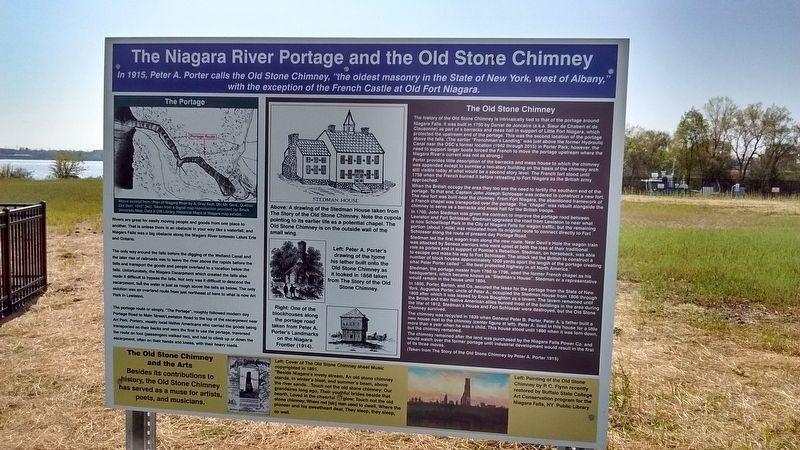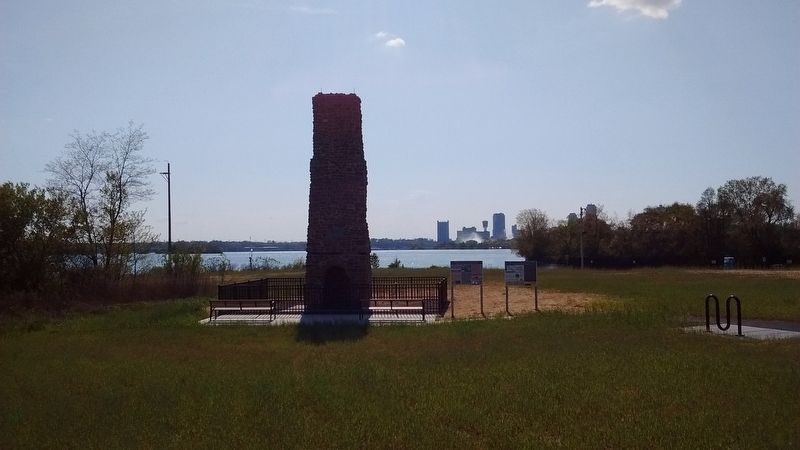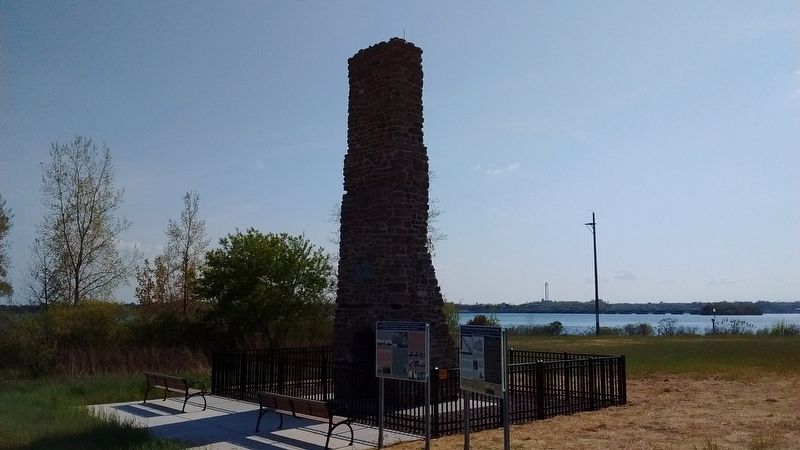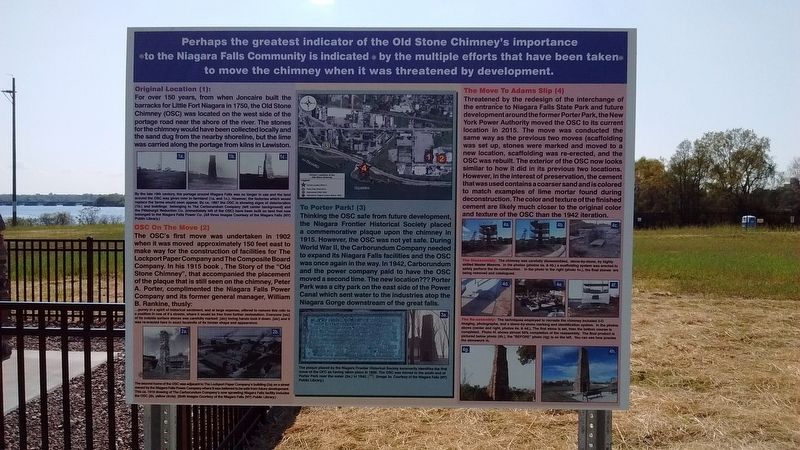The Niagara River Portage and the Old Stone Chimney
The Portage
Rivers are great for easily moving people and goods from one place to another. That is unless these is an obstacle in your way like a waterfall; and Niagara Falls was a big obstacle along the Niagara River between Lakes Erie and Ontario.
The only way around the falls before the digging of the Welland Canal and the later rise of railroads was to leave the river above the rapids before the falls and transport the goods and people overland to a location below the falls. Unfortunately, the Niagara Escarpment which created the falls also made it difficult to bypass the falls. Not only was it difficult to descend the escarpment, bu the water is just as rough above the falls as below. the only solution was an overland route from just northeast of here to what is not Art Park in Lewiston.
The portage route or simply, "the Portage", roughly followed modern day Portage Road to Main Street / Lewiston Road to the top of the escarpment near Art Park. Porters, mostly local native Americans who carried the goods being transported on their backs and were the first to use the portage, traversed the route on foot (passengers walked too),
and had to climb up or down the escarpment, often on their hands and knees, with their heavy loads.
The Old Stone Chimney
The history of the Old Stone Chimney is intrinsically tied to that of the portage around Niagara Falls. It was build in 1750 by Daniel de Joncaire (a.k.a. Sieur de Chabert et de Clausonne) as part of a barracks and mess hall in support of the Little Fort Niagara, which protected the upstream end of the portage. This was the second location of the portage above the falls. (The earlier "Frenchman's Landing" was just above the former Hydraulic Canal near the OSC's former location (1942 through 2015) in Porter Park; however, the meed to support larger boats forced the French to move the portage upstream where the Niagara River's current was not as strong.)
Porter provides little description of the barracks and mess house to which the chimney was appended except to surmise a two-story building on the basis of the chimney arch still visible today at what would be a second story level. The French fort stood until 1759 when the French burned it before retreating to Fort Niagara as the British army approached.
When the British occupy the area they too see the need to fortify the southern end of the portage. to that end, Captain John Joseph Schlosser was ordered to construct a new fort. The new fort was built near the chimney. From Fort
Niagara, the abandoned framework of a French chapel was transported over the portage. the "chapel" was rebuilt alongside the chimney to serve as a barracks and mess hall for the British troops.In 1760, John Stedman was given the contract to improve the portage road between Lewiston and Fort Schlosser. Stedman upgraded the road from Lewiston to near what is now Schoellkopf Park in the City of Niagara Falls for wagon traffic, but the remaining portion (about 1 mile) was relocated from its original route to connect directly to Fort Schlosser along the route of present day Portage Road.
Stedman led the first wagon train along the new route. Near Devil's Hole the wagon train was attacked by Seneca warriors who were upset at both the loss of their traditional role as porters and in support of Pontiac's Rebellion. Stedman, on horseback, was able to escape and make his way to Fort Schlosser. the attack led the British to construct a number of block houses approximately 1200 yards apart the length of the portage creating what Peter Porter called "...the best protected highway in all North America."
Stedman, the portage master from 1760 to 1796, used the former French chapel as his headquarters, which became known as "Stedman's House". Stedman or a representative would remain in the house until 1804.
In 1805, Porter, Barton, and Co., secured the lease for the portage
from the State of New York. Augustus Porter, uncle of Peter A., occupied the Stedman House from 1806 through 1808 after which it was leased by Enos Boughton as a tavern. The tavern remained until the British and their Native American allies burned most of the building in the area during the War of 1812. Stedman's House and Fort Schlosser were destroyed, but the Old Stone Chimney survived.The chimney was recycled in 1839 when General Peter B. Porter, Peter A.'s father built a new house next to the chimney (center figure at left). Peter A. lived in this house for a little more than a year when he was a child. This house stood until 1880 when it was torn down, but the chimney remained.
The chimney remained after the land was purchased by the Niagara Falls Power Co., and would watch over the former portage until industrial development would result in the first of its three moves.
(Taken from the Story of the Old Stone Chimney by Peter A. Porter 1915)
Topics. This historical marker is listed in these topic lists: Architecture • Colonial Era • Settlements & Settlers • Waterways & Vessels. A significant historical year for this entry is 1750.
Location. 43° 4.733′ N, 79° 2.717′ W. Marker is in Niagara Falls, New York, in Niagara County. Marker is on Robert Moses Parkway, on the right when traveling east.
Other nearby markers. At least 8 other markers are within walking distance of this marker. Old Stone Chimney (a few steps from this marker); Niagara River Overlook (approx. 0.2 miles away); Portage Road (approx. 0.4 miles away); Holy Trinity Roman Catholic Church Complex (approx. half a mile away); Historic Falls Portage (approx. 0.6 miles away); Thomas V. Welch (approx. 0.6 miles away); Whitney Mansion (approx. 0.7 miles away); The Parting of the Waters (approx. 0.8 miles away). Touch for a list and map of all markers in Niagara Falls.
Also see . . . The Old Stone Chimney. (Submitted on August 8, 2016, by Tom Bosse of Jefferson City, Tennessee.)
Credits. This page was last revised on August 11, 2016. It was originally submitted on August 8, 2016, by Tom Bosse of Jefferson City, Tennessee. This page has been viewed 479 times since then and 29 times this year. Photos: 1, 2, 3, 4. submitted on August 8, 2016, by Tom Bosse of Jefferson City, Tennessee. • Bill Pfingsten was the editor who published this page.



